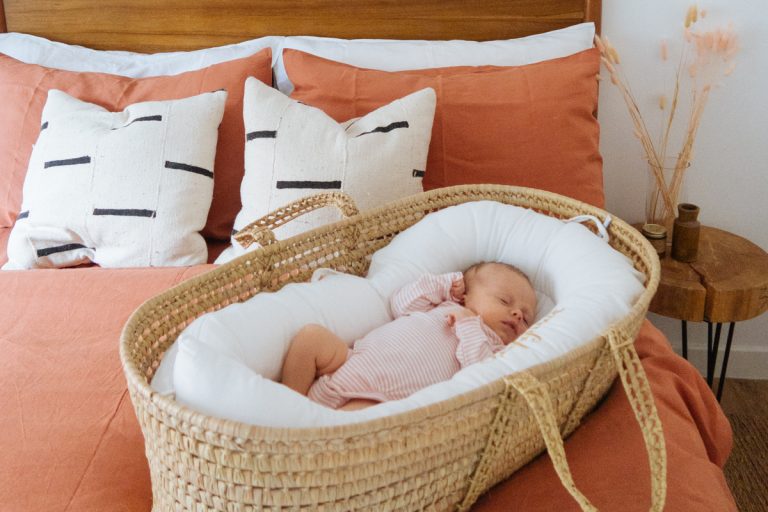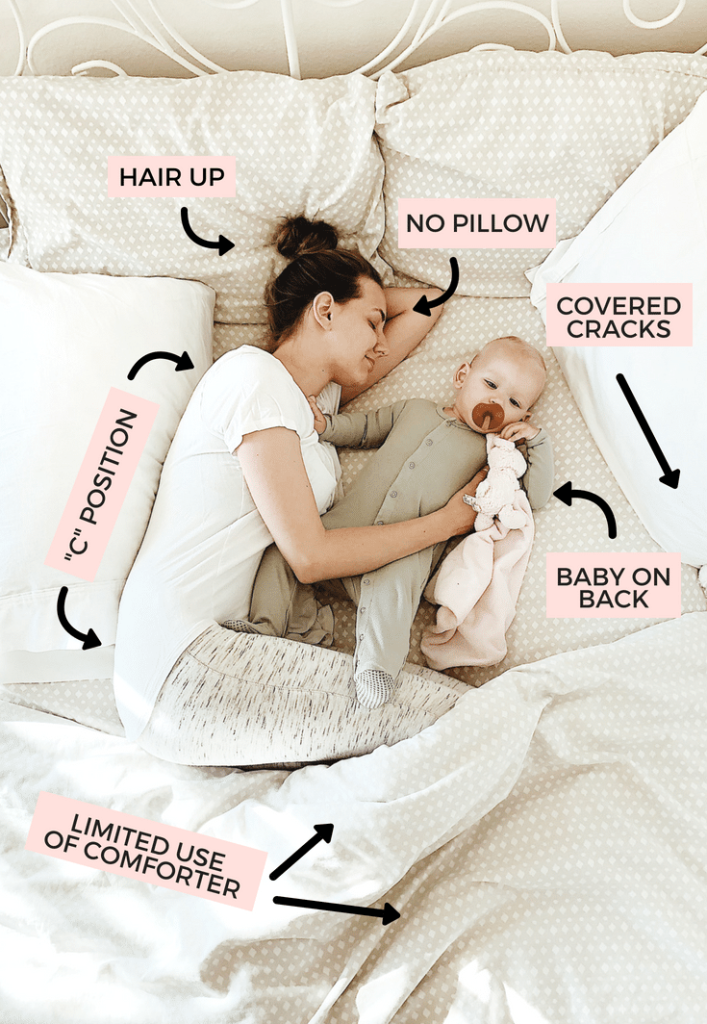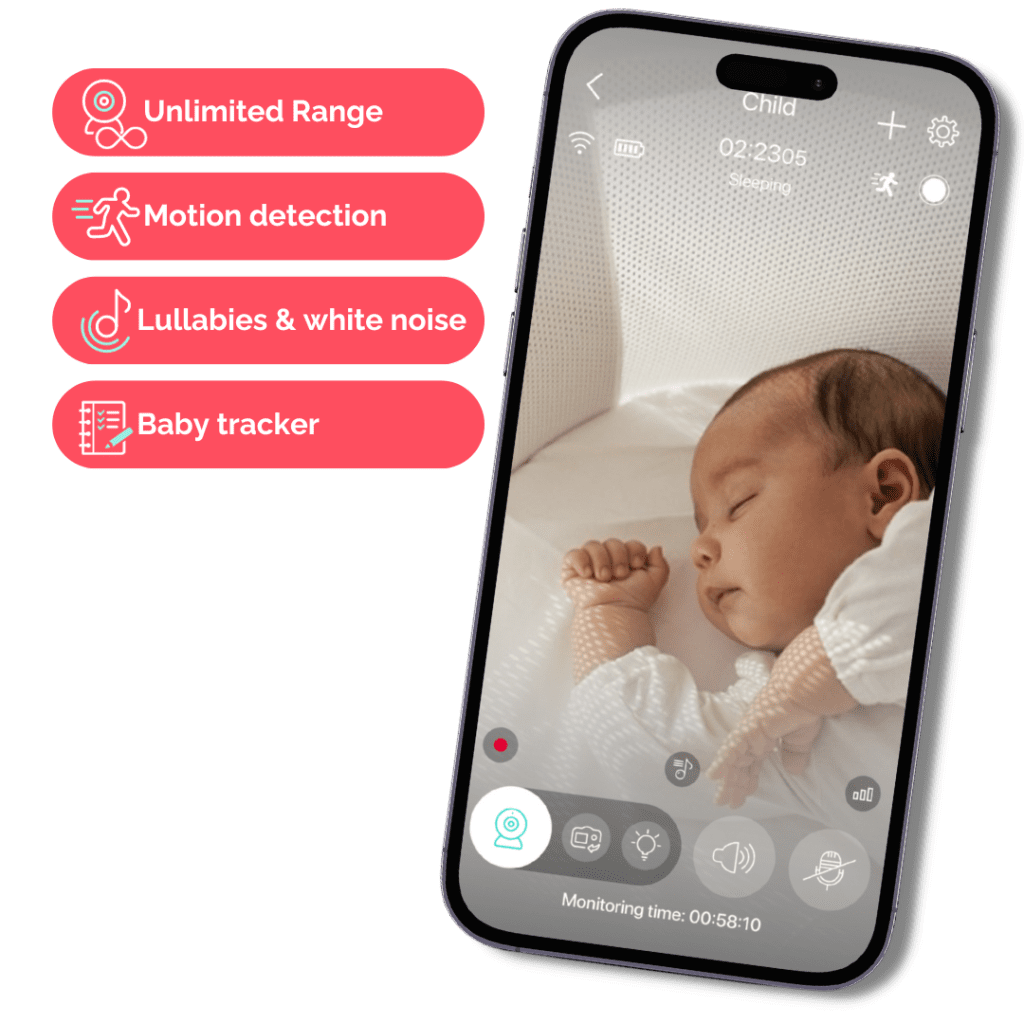
How to Keep Your Sleeping Baby Safe? Here Are the Safe Sleep Tips
- Created:
17. 1. 2023 - Updated:
15. 2. 2024
It’s fact:
The number of child deaths during sleep has significantly decreased since 1990 when the recommendation to place babies on their backs was introduced.
That said:
It is also recommended to keep blankets, pillows, bumper pads, and soft toys out of the sleeping area as part of safe sleep practices today.
Additional:
Room sharing is recommended, but not bed-sharing.
Because we know this:
We’ve outlined some useful tips to help you learn more about how to reduce the risk of infant deaths in sleep, including sudden infant death syndrome (SIDS), accidental suffocation, and death from unknown causes.
Safe Sleep for Infants: How to Reduce the Risk of Sids?
Place your baby on their back when they sleep. Share a room with your baby, but not a bed. The baby should sleep on a firm, flat surface, on a mattress in a crib. Ensure baby’s sleep area is free of soft bedding, such as blankets, pillows, cushions, and soft toys.
Safe Sleep for Infants: Do and Don’t
| DO | DON’T |
|---|---|
| ✔️ Ensure that your baby sleeps on back. | ❌ Don’t expose your baby to fire, radiators or direct sunlight. |
| ✔️ Keep your sleeping baby close to you day and night. | ❌ Don’t leave your sleeping baby wearing warm outdoor clothing when indoors. |
| ✔️ The mattress should be firm, flat, clean, well-fitting, and covered with a sheet that fits tightly. | ❌ Don’t ever share with your baby a bed. |
| ✔️ Choose clothing without strings or ties that could cause strangulation. | ❌ Don’t put soft bedding, such as blankets, pillows, cushions, and soft toys in the crib. |
| ✔️ Make sure your baby is not too hot or too cold while sleeping. | ❌ Don’t expose your baby to cigarette smoke at any time. |
Safe Sleep for Infants: Co-Sleeping, Room-Sharing, and Bed-Sharing
The terms “bed-sharing” and “co-sleeping” are often used interchangeably, but there are some differences:
Co-Sleeping:
This means that parent and baby sleep in close social contact. Which means that each can know the other is nearby.
Bed-sharing and room-sharing are two types of co-sleeping:
Room-Sharing:
This means the crib is near the parent’s bed. So the parents sleep near the baby. However, the baby has its own place to sleep.
Bed-Sharing:
This means that parent and baby sleep together in bed, on the couch or in a chair. This raises problems because sharing a bed with an infant increases the risk of sleep-related deaths, including sudden infant death syndrome (SIDS).
When Is Bed-Sharing Safe?
It is safe to sleep in the same bed as your baby as long as you sleep facing your baby (your thighs should prevent him or her from slipping under the covers).
Pillows and blankets should not be on the bed and certainly not near the baby. Make sure everyone in the bed knows your baby is there.
If you have older children and want to sleep in the same bed, then leave an adult between the older children and the baby.
Keep in mind:
Even if you follow safety tips for sleeping in the same bed, they don’t reduce the risk of danger. Bed-sharing increases the chance of suffocation, strangulation, and SIDS.

The Risks of Baby Sleep: Accidents, SIDS
All babies under one year of age are at risk of sudden infant death syndrome (SIDS), especially those under six months of age. But SIDS is not the only danger.
Accidents
Baby sleep in different places and at different times. Accidental injury can occur wherever a baby sleeps.
Baby may become wedged between furniture or against a parent’s body, fall off a sleep surface, or risk suffocation or strangulation from pillows, cords or blankets.
Anything that impairs your ability to respond to a baby’s danger, such as alcohol, drugs, or certain medications, and that may affect your judgment, may pose a risk to the baby.
SIDS
SIDS or Sudden Infant Death Syndrome is a condition in which a baby stops breathing in its sleep for no apparent reason. If the respiratory arrest is not attended to in time and helped, the baby may die.
How Does SIDS Occur?
Unfortunately, experts do not yet know how sudden infant death syndrome is caused.
While certain risk factors increase the possibility of its occurrence, it can affect any child.
The most insidious thing about SIDS is that it comes on during sleep. The baby does not scream, and no one knows about its silent struggle for life.
SIDS affects boys more often than girls and is most common between the 2nd and 4th month of a baby’s age.
Risk Factors for Sudden Infant Death Syndrome:
- The baby is sleeping in the tummy position.
- The mother smoked during pregnancy.
- The mother suffers from alcohol or drug addiction.
- The baby has some defect or disease of the lungs.
- The baby is exposed to second-hand smoke.
- The child was born prematurely.
- The child had a lower birth weight (less than 2 500 g).
- SIDS has already occurred in the family.
What to Do if SIDS Occurs?
If the baby is not breathing, you must act quickly and rationally.
Here is a guide on how to help your baby with SIDS:
- Call the emergency medical services immediately – 911.
- Empty the baby’s mouth and nose.
- In the supine position, breathe into the mouth and nose simultaneously for about 30 breaths per minute, but only inhale the mouth’s contents, as the child has smaller lungs.
- Massage the heart by squeezing the lower edge of the sternum to a depth of only 2-3 cm at a rate of approximately 90 compressions per minute for newborns and a ratio of 3:1 (3 compressions – 1 breath). In infants at a ratio of 30:2 (30 compressions : 2 breaths).
The most important thing is to find out that the baby has stopped breathing!

Do not underestimate the prevention and use of technology for early detection of SIDS – baby breathing monitor and baby monitor.
Safe Sleep for Infants: How to Reduce the Risk of SIDS
Sleeping on the back is an important prevention of SIDS.
Since paediatricians began recommending the supine position, the incidence of SIDS has decreased significantly.
Place your baby in the supine position, and if you find that he/she has turned onto his tummy in his sleep, change his position.
With a runny nose and other respiratory problems, it is recommended to pad the mattress a little so that the baby’s head is slightly elevated. But never give a pillow to a baby under one year.
Remove all objects from the baby’s crib that could cover the baby’s airway while sleeping.
Apart from the baby in the swaddle or sleeping bag, there should be nothing else in the crib.
At most, however, the fabric protection inside the crib walls should permanently be securely attached to the crib.
This also applies if we want to shade the baby. Never use any head covering – cloth etc.
It is best to put the baby to sleep in the parent’s bedroom in a crib.
Never sleep with the baby in the same bed.
There is a risk of unintentional lying down of the baby, but also tangling the baby in the bedding and subsequent suffocation.
However, putting the baby in a crib in another room is equally inappropriate.
Parents could sleep through a crisis.
In addition:
Sleeping in the same room calms the baby, and parents have the opportunity to feed or hold the baby whenever needed.
The optimal temperature for sleeping is between 60.8- 68°F.
At the same time, the baby should be appropriately dressed.
Cold hands and nose are a sign of poor clothing.
Overheating, in turn, reveals red cheeks. When a child is overheated, the back of the neck is moist to the touch with sweat.
Dress the baby appropriately so that it’s warm but not too hot.
Overheating can also be a risk factor.
The baby should sleep on its back in a separate crib in a baby sleep sack.
Pacifiers reduce the risk of SIDS.
There are multiple theories as to why this is so.
Offer your baby a pacifier, but if he/she doesn’t want it, don’t force it.
Maintain a smoke-free home and no smoking during pregnancy.
Both reduce the risk of SIDS.
This is because nicotine has a dampening effect on the breathing system.
Breastfeeding is recommended for at least the first six months of life.
According to some scientific studies, breastfeeding also prevents SIDS, mainly because of its beneficial effects on the overall growth and development of the child.
Final Tip: Annie Baby Monitor – A Guardian for Safe Sleep
Keep an eye on your sleeping babyconstantly, and make sure they’re safe at all times. Check out Annie Baby Monitor.
This awesome baby monitor app has everything you need to keep an eye on your little one’s safety. You get live video and audio monitoring plus instant alerts if anything – it detects motion, sound, and crying.

With Annie by your side, you can finally catch a break and relax, knowing that your little one is being looked after 24/7. So why wait? Get Annie Baby Monitor today and sleep easy tonight!
Conclusion
All in all:
To keep your baby safe during sleep, there are three basic rules for safe sleep for infants: The baby should sleep on the BACK, ALONE in a CRIB.
Remember, the factors to take note of are:
- remove all objects from the baby’s crib
- room-share but never bed-share
- keep the baby warm but not too hot
- 60.8-68°F is the ideal temperature for sleeping
- breastfeed for at least six months
- use pacifiers
- keep your home smoke-free
Note that:
Although you follow the guidelines and tips to prevent SIDS, it can occur in any child.
Hence:
It is important to know not only safe sleep tips to prevent SIDS. But also to know how to help your baby when SIDS occur.
FAQ: Safe Sleep for Infants
AAP (American Academy of Pediatrics) considers the following to be safe sleep for babies:
– To put the baby to sleep on back in own sleeping space without other people and things in the crib.
– Use a crib, bassinet or portable basket. The mattress should be firm and flat. The baby should not sleep on a couch, chair or in a seating device (except a car seat while riding in a car).
– Blankets, pillows, soft toys, pacifiers and other soft items should not be loose in the baby’s sleeping area.
– Breastfeed as long as possible. Breastfeeding helps reduce the risk of SIDS.
– Do not smoke around the baby or wear things soaked in smoke.
1. Lay your baby on their back.
2. The sleeping surface should be firm and flat.
3. The baby should sleep alone. Share a room with your baby, not a bed.
4. Be sure your baby’s sleeping area is free of soft objects and loose bedding.
Make sure your baby sleeps on a firm, flat surface like a crib mattress with a snug-fitting sheet.
The baby’s sleeping area should be in the same room as yours, ideally until the baby is six months old. Monitor the breathing of your baby with a breathing monitor.
The safest place for babies to sleep is on a firm mattress in a crib, cradle or playpen.
You should also ensure the baby sleeps on its back and on its own – no stuffed animals, blankets, or any soft things.
Parents and babies should sleep in the same room – NOT IN THE SAME BED.






